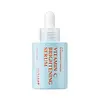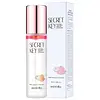What's inside
What's inside
 Key Ingredients
Key Ingredients

 Benefits
Benefits

 Concerns
Concerns

 Ingredients Side-by-side
Ingredients Side-by-side

Water
Skin ConditioningMethylpropanediol
SolventPropanediol
SolventGlycerin
Humectant1,2-Hexanediol
Skin ConditioningNiacinamide
SmoothingBetaine
Humectant3-O-Ethyl Ascorbic Acid
Skin ConditioningTocopheryl Acetate
AntioxidantPanthenol
Skin ConditioningBifida Ferment Lysate
Skin ConditioningChlorella Vulgaris Extract
Skin ConditioningSodium Hyaluronate
HumectantMelia Azadirachta Flower Extract
Skin ConditioningMelia Azadirachta Leaf Extract
Skin ConditioningHydrolyzed Hyaluronic Acid
HumectantCurcuma Longa Root Extract
MaskingOcimum Sanctum Leaf Extract
Skin ConditioningCorallina Officinalis Extract
Skin ConditioningHyaluronic Acid
HumectantHydrolyzed Collagen
EmollientSodium Hyaluronate Crosspolymer
HumectantHydroxyethyl Urea
HumectantGlucose
HumectantHydrolyzed Glycosaminoglycans
HumectantTrehalose
HumectantButylene Glycol
HumectantFructooligosaccharides
HumectantFructose
HumectantTromethamine
BufferingBenzyl Glycol
SolventAdenosine
Skin ConditioningSodium Citrate
BufferingSodium Phytate
Citric Acid
BufferingEthylhexylglycerin
Skin ConditioningPolysorbate 20
EmulsifyingPalmitoyl Tripeptide-1
Skin ConditioningPalmitoyl Tetrapeptide-7
Skin ConditioningAscorbic Acid
AntioxidantBiotin
AntiseborrhoeicCyanocobalamin
Skin ConditioningFolic Acid
Skin ConditioningPantothenic Acid
Skin ConditioningPyridoxine
Skin ConditioningRiboflavin
Cosmetic ColorantThiamine Hcl
MaskingBioflavonoids
Skin ConditioningGlutathione
Linoleic Acid
CleansingMenadione
MaskingRetinol
Skin ConditioningTocopherol
AntioxidantCarbomer
Emulsion StabilisingXanthan Gum
EmulsifyingWater, Methylpropanediol, Propanediol, Glycerin, 1,2-Hexanediol, Niacinamide, Betaine, 3-O-Ethyl Ascorbic Acid, Tocopheryl Acetate, Panthenol, Bifida Ferment Lysate, Chlorella Vulgaris Extract, Sodium Hyaluronate, Melia Azadirachta Flower Extract, Melia Azadirachta Leaf Extract, Hydrolyzed Hyaluronic Acid, Curcuma Longa Root Extract, Ocimum Sanctum Leaf Extract, Corallina Officinalis Extract, Hyaluronic Acid, Hydrolyzed Collagen, Sodium Hyaluronate Crosspolymer, Hydroxyethyl Urea, Glucose, Hydrolyzed Glycosaminoglycans, Trehalose, Butylene Glycol, Fructooligosaccharides, Fructose, Tromethamine, Benzyl Glycol, Adenosine, Sodium Citrate, Sodium Phytate, Citric Acid, Ethylhexylglycerin, Polysorbate 20, Palmitoyl Tripeptide-1, Palmitoyl Tetrapeptide-7, Ascorbic Acid, Biotin, Cyanocobalamin, Folic Acid, Pantothenic Acid, Pyridoxine, Riboflavin, Thiamine Hcl, Bioflavonoids, Glutathione, Linoleic Acid, Menadione, Retinol, Tocopherol, Carbomer, Xanthan Gum
Water
Skin ConditioningDipropylene Glycol
HumectantGlycerin
HumectantButylene Glycol
HumectantCaprylic/Capric Triglyceride
Masking1,2-Hexanediol
Skin ConditioningMethylpropanediol
SolventIsohexadecane
EmollientCyclopentasiloxane
EmollientSodium Chloride
MaskingCyclohexasiloxane
EmollientParfum
MaskingCalcium Disodium EDTA
Ethylhexylglycerin
Skin ConditioningNasturtium Officinale Extract
PerfumingMorus Alba Leaf Extract
Skin ConditioningRosa Rugosa Flower Water
MaskingGalactomyces Ferment Filtrate
HumectantCarum Carvi Seed Oil
MaskingPhenoxyethanol
PreservativeArgania Spinosa Kernel Oil
EmollientPersea Gratissima Oil
Skin ConditioningOlea Europaea Fruit Oil
MaskingSimmondsia Chinensis Seed Oil
EmollientVitis Vinifera Seed Oil
EmollientElettaria Cardamomum Fruit Extract
AntimicrobialTerminalia Ferdinandiana Fruit Extract
AntioxidantRosa Canina Fruit Extract
AstringentMantis Extract
Skin ConditioningVitex Trifolia Fruit Extract
Skin ConditioningMalpighia Emarginata Fruit Extract
Skin ConditioningPersea Gratissima Fruit Extract
EmollientRosa Damascena Flower Oil
MaskingTocopherol
AntioxidantWater, Dipropylene Glycol, Glycerin, Butylene Glycol, Caprylic/Capric Triglyceride, 1,2-Hexanediol, Methylpropanediol, Isohexadecane, Cyclopentasiloxane, Sodium Chloride, Cyclohexasiloxane, Parfum, Calcium Disodium EDTA, Ethylhexylglycerin, Nasturtium Officinale Extract, Morus Alba Leaf Extract, Rosa Rugosa Flower Water, Galactomyces Ferment Filtrate, Carum Carvi Seed Oil, Phenoxyethanol, Argania Spinosa Kernel Oil, Persea Gratissima Oil, Olea Europaea Fruit Oil, Simmondsia Chinensis Seed Oil, Vitis Vinifera Seed Oil, Elettaria Cardamomum Fruit Extract, Terminalia Ferdinandiana Fruit Extract, Rosa Canina Fruit Extract, Mantis Extract, Vitex Trifolia Fruit Extract, Malpighia Emarginata Fruit Extract, Persea Gratissima Fruit Extract, Rosa Damascena Flower Oil, Tocopherol
 Reviews
Reviews

Ingredients Explained
These ingredients are found in both products.
Ingredients higher up in an ingredient list are typically present in a larger amount.
1,2-Hexanediol is a synthetic liquid and another multi-functional powerhouse.
It is a:
- Humectant, drawing moisture into the skin
- Emollient, helping to soften skin
- Solvent, dispersing and stabilizing formulas
- Preservative booster, enhancing the antimicrobial activity of other preservatives
Butylene Glycol (or BG) is used within cosmetic products for a few different reasons:
Overall, Butylene Glycol is a safe and well-rounded ingredient that works well with other ingredients.
Though this ingredient works well with most skin types, some people with sensitive skin may experience a reaction such as allergic rashes, closed comedones, or itchiness.
Learn more about Butylene GlycolEthylhexylglycerin (we can't pronounce this either) is commonly used as a preservative and skin softener. It is derived from glyceryl.
You might see Ethylhexylglycerin often paired with other preservatives such as phenoxyethanol. Ethylhexylglycerin has been found to increase the effectiveness of these other preservatives.
Glycerin is already naturally found in your skin. It helps moisturize and protect your skin.
A study from 2016 found glycerin to be more effective as a humectant than AHAs and hyaluronic acid.
As a humectant, it helps the skin stay hydrated by pulling moisture to your skin. The low molecular weight of glycerin allows it to pull moisture into the deeper layers of your skin.
Hydrated skin improves your skin barrier; Your skin barrier helps protect against irritants and bacteria.
Glycerin has also been found to have antimicrobial and antiviral properties. Due to these properties, glycerin is often used in wound and burn treatments.
In cosmetics, glycerin is usually derived from plants such as soybean or palm. However, it can also be sourced from animals, such as tallow or animal fat.
This ingredient is organic, colorless, odorless, and non-toxic.
Glycerin is the name for this ingredient in American English. British English uses Glycerol/Glycerine.
Learn more about GlycerinMethylpropanediol is a synthetic solvent and humectant.
As a solvent, it helps dissolve other ingredients, helping to evenly distribute ingredients throughout the product. This ingredient has also been shown to have antimicrobial properties which makes it a preservative booster.
Methylpropanediol is able to add a bit of moisture to the skin. It also helps other ingredients be better absorbed into the skin, such as salicylic acid.
Learn more about MethylpropanediolTocopherol (also known as Vitamin E) is a common antioxidant used to help protect the skin from free-radicals and strengthen the skin barrier. It's also fat soluble - this means our skin is great at absorbing it.
Vitamin E also helps keep your natural skin lipids healthy. Your lipid skin barrier naturally consists of lipids, ceramides, and fatty acids. Vitamin E offers extra protection for your skin’s lipid barrier, keeping your skin healthy and nourished.
Another benefit is a bit of UV protection. Vitamin E helps reduce the damage caused by UVB rays. (It should not replace your sunscreen). Combining it with Vitamin C can decrease sunburned cells and hyperpigmentation after UV exposure.
You might have noticed Vitamin E + C often paired together. This is because it is great at stabilizing Vitamin C. Using the two together helps increase the effectiveness of both ingredients.
There are often claims that Vitamin E can reduce/prevent scarring, but these claims haven't been confirmed by scientific research.
Learn more about TocopherolWater. It's the most common cosmetic ingredient of all. You'll usually see it at the top of ingredient lists, meaning that it makes up the largest part of the product.
So why is it so popular? Water most often acts as a solvent - this means that it helps dissolve other ingredients into the formulation.
You'll also recognize water as that liquid we all need to stay alive. If you see this, drink a glass of water. Stay hydrated!
Learn more about Water